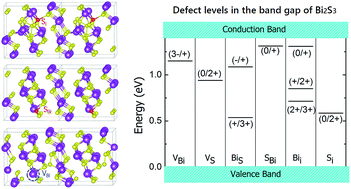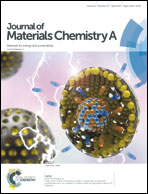Influence of defects and dopants on the photovoltaic performance of Bi2S3: first-principles insights
Abstract
Bi2S3 has attracted extensive attention recently as a light-absorber, sensitizer or electron acceptor material in various solar cells. Using first-principles calculations, we find that the photovoltaic efficiency of Bi2S3 solar cells is limited by its intrinsic point defects, i.e., both S vacancy and S interstitial can have high concentration and produce deep defect levels in the bandgap, leading to non-radiative recombination of electron–hole carriers and reduced minority carrier lifetime. Unexpectedly most of the intrinsic defects in Bi2S3, including even the S interstitial, act as donor defects, explaining the observed n-type conductivity and also causing the high p-type conductivity impossible thermodynamically. Doping in Bi2S3 by a series of extrinsic elements is studied, showing that most of the dopant elements such as Cu, Br and Cl make the material even more n-type and only Pb doping makes it weakly p-type. Based on this, we propose that the surface region of n-type Bi2S3 nanocrystals in p-PbS/n-Bi2S3 nano-heterojunction solar cells may be type-inverted into p-type due to Pb doping, with a buried p–n junction formed in the Bi2S3 nanocrystals, which provides a new explanation to the longer carrier lifetime and higher efficiency [Nat. Photonics, 6, 529 (2012)]. Considering the relatively low conduction band and high n-type conductivity, we predict that Cu, Br and Cl doped Bi2S3 may be an ideal n-type electron acceptor or counter electrode material, while the performance of Bi2S3 as a light-absorber or sensitizer material is intrinsically limited.



 Please wait while we load your content...
Please wait while we load your content...